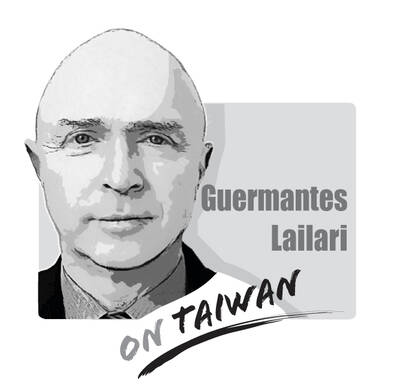“If you tell a lie big enough and keep repeating it, people will eventually come to believe it.”
That saying from a notorious propaganda chief seems to be what President Ma Ying-jeou’s (馬英九) government is aiming for with its so-called “1992 consensus” — which has become a ubiquitous term among Chinese Nationalist Party (KMT) and Chinese officials alike.
Never mind the fact that former Mainland Affairs Council chairman Su Chi (蘇起) in 2006 openly admitted fabricating the term in 2000 before the KMT handed power over to the Democratic Progressive Party, nor the fact that China has made it clear that the “1992 consensus” is just another way of describing its “one country, two systems” policy — which does not at all recognize that each side of the Taiwan Strait has its own interpretation of what “one China” means. The Ma administration has nonetheless stuck to this lie, as it continues to deceive the Taiwanese public and toe Beijing’s line.
Following Chinese President Xi Jinping’s (習近平) warning earlier last month that there would be “earthshaking” consequences to cross-strait relations if the political basis of the “1992 consensus” is challenged, Ma yesterday reiterated the importance of the so-called consensus as a “foundation for peaceful cross-strait development” by further threatening his own people that cross-strait relations would descend into “chaos” if people go against it.
It is one thing for China to sell its interpretation of the “1992 consensus” to members of the international community, as it has made no secret of its ambition to annex Taiwan. However, it is another thing when a head of state like Ma, who was elected by his own people, resorts to such tactics and allows Beijing to take advantage of the people with nary a protest.
“I deeply believe that peace and prosperity are the future of the two sides [of the Taiwan Strait] ... and what most Taiwanese expect,” Ma said in a speech during a visit to the Mainland Affairs Council, which council officials said was timed to commemorate the first high-level cross-strait meeting 22 years ago in Singapore.
Indeed, no one objects to having peaceful cross-strait relations, but peace must not be built on Taiwan’s voluntary denigration of its own status and forsaking its dignity as a sovereign state.
If Ma genuinely cares for peaceful cross-strait development, the dignity of the Republic of China which he represents, as well as the well-being of Taiwanese, rather than hanging on to the spurious “1992 consensus” and pushing the nation toward Beijing’s “one China” framework, he should speak out against China’s “Anti-Secession Law” and urge Beijing to revoke it.
While the law, enacted in 2005, claims to promote peaceful unification, it provides a legal basis, from the Chinese perspective, to rein in Taiwanese independence and facilitate the nation’s annexation through the use of military force. It clearly stipulates that Beijing — in the event that “Taiwanese independence” forces act under any name or by any means to cause Taiwan’s secession from China — shall employ non-peaceful means and other necessary measures “to protect China’s sovereignty and territorial integrity.”
The motive and content of the law show nothing but malice and threats to peace on Beijing’s part.
It is downright pathetic that the Ma government believes in a consensus that does not really exist, all the while lacking the guts to stand up to Chinese aggression and bullying.

There is much evidence that the Chinese Communist Party (CCP) is sending soldiers from the People’s Liberation Army (PLA) to support Russia’s invasion of Ukraine — and is learning lessons for a future war against Taiwan. Until now, the CCP has claimed that they have not sent PLA personnel to support Russian aggression. On 18 April, Ukrainian President Volodymyr Zelinskiy announced that the CCP is supplying war supplies such as gunpowder, artillery, and weapons subcomponents to Russia. When Zelinskiy announced on 9 April that the Ukrainian Army had captured two Chinese nationals fighting with Russians on the front line with details
Within Taiwan’s education system exists a long-standing and deep-rooted culture of falsification. In the past month, a large number of “ghost signatures” — signatures using the names of deceased people — appeared on recall petitions submitted by the Chinese Nationalist Party (KMT) against Democratic Progressive Party legislators Rosalia Wu (吳思瑤) and Wu Pei-yi (吳沛憶). An investigation revealed a high degree of overlap between the deceased signatories and the KMT’s membership roster. It also showed that documents had been forged. However, that culture of cheating and fabrication did not just appear out of thin air — it is linked to the
The Chinese Nationalist Party (KMT), joined by the Taiwan People’s Party (TPP), held a protest on Saturday on Ketagalan Boulevard in Taipei. They were essentially standing for the Chinese Communist Party (CCP), which is anxious about the mass recall campaign against KMT legislators. President William Lai (賴清德) said that if the opposition parties truly wanted to fight dictatorship, they should do so in Tiananmen Square — and at the very least, refrain from groveling to Chinese officials during their visits to China, alluding to meetings between KMT members and Chinese authorities. Now that China has been defined as a foreign hostile force,
On April 19, former president Chen Shui-bian (陳水扁) gave a public speech, his first in about 17 years. During the address at the Ketagalan Institute in Taipei, Chen’s words were vague and his tone was sour. He said that democracy should not be used as an echo chamber for a single politician, that people must be tolerant of other views, that the president should not act as a dictator and that the judiciary should not get involved in politics. He then went on to say that others with different opinions should not be criticized as “XX fellow travelers,” in reference to